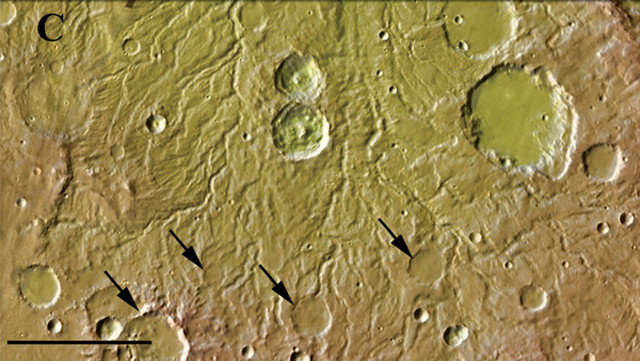
by Timothy Oleson Wednesday, July 19, 2017

As Mars' atmosphere thinned early in its history, raindrops would have grown larger and fallen faster, affecting the planet's geomorphology — from crater rims to drainage valleys — in different ways at different times. Credit: Craddock and Lorenz, Icarus, April 2017.
With two rovers patrolling the surface of Mars, six spacecraft orbiting above it, and scientists here on Earth studying the Red Planet from afar, new findings are announced often. Here are a few of the latest updates.
Nearly two-thirds of Mars’ atmospheric argon has been stripped away by the solar wind, according to a study in Science. Lighter argon-36 is more prone to rising higher in the atmosphere than heavier argon-38, and is thus more easily lost to space through a process called sputtering, in which ions accelerated by the solar wind knock atmospheric gases beyond the reach of a planet’s gravity. This process has left the Martian atmosphere enriched with argon-38 to different extents at different altitudes. Using measurements from NASA’s MAVEN (Mars Atmosphere and Volatile Evolution Mission) spacecraft, researchers quantified the abundance and ratio of the isotopes at different altitudes above Mars, finding that 66 percent of the planet’s total atmospheric argon has been lost over time. Other gases are lost via the same mechanism. “We determined that the majority of the planet’s carbon dioxide also has been lost to space by sputtering,” said University of Colorado Boulder geologist Bruce Jakosky, the principal investigator for MAVEN and lead author of the study, in a statement.
Mars may have had rings up to seven times in the past and will likely sport them again in the (geologically) near future, according to new research in Nature Geoscience. Mars’ rings could have first formed after a large impactor struck the planet 4.3 billion years ago, gouging the surface and sending debris into orbit, according to simulations by Andrew Hesselbrock and David Minton of Purdue University. This debris would have then accreted to form moons, before subsequently disintegrating and reforming rings in a back-and-forth cycle that the simulations suggested has occurred between three and seven times. The orbit of Phobos, the larger and innermost of the Red Planet’s two current moons, is known to be shrinking slowly; and with its rocky composition only weakly held together, the new modeling suggested Phobos could break up again under the pull of Mars’ gravity in about 70 million years, reforming Mars’ rings once again. Prior work by another group suggested rings could form from Phobos even sooner — in 20 million to 40 million years.
In a new study in Icarus, researchers have applied knowledge about the physics of rainfall on Earth — including how pressure and gravity influence the size and speed of raindrops — to Martian geomorphology. Early in its history, when Mars had a much thicker atmosphere and liquid water flowed on the planet, water probably evaporated and precipitated as it does on Earth — and, also as on Earth, this rain would have played a role in shaping geologic features on Mars’ surface. Robert Craddock, of the National Air and Space Museum in Washington, D.C., and Ralph Lorenz, of Johns Hopkins University, found that likely atmospheric pressures of 2 to 4 bars roughly 4 billion years ago would have created fog-like precipitation on Mars that could have eroded impact craters but would not have been powerful enough to carve the networks of valleys and channels observed on the planet. As the Martian atmosphere thinned, however, raindrops would have grown larger — up to 7.3 millimeters in diameter at pressures equivalent to Earth’s modern atmosphere — and hit the ground harder. When atmospheric pressures dropped below about 1.5 to 2 bars, these raindrops would have carried enough force to excavate surface soils, eventually creating valley drainage networks.
In May, a European Space Agency (ESA) inquiry board completed its review of the failed descent of the Schiaparelli lander, which, after separating from the Trace Gas Orbiter and entering Mars’ atmosphere, crashed to the planet’s surface on Oct. 19, 2016. ESA found that unexpectedly large wobbles experienced by Schiaparelli when its parachute deployed caused its computer to incorrectly calculate the lander’s position and orientation, with the navigation system then determining the lander was (impossibly) at a negative altitude. This error triggered the craft to jettison its parachute too soon and fire its braking thrusters for the minimum of three seconds, resulting in the lander free-falling to the surface from 3.7 kilometers up. In addition to technical errors and insufficient fail-safes in the navigation software, the board identified shortcomings in prelaunch testing as well as in the oversight of Schiaparelli’s development.
© 2008-2021. All rights reserved. Any copying, redistribution or retransmission of any of the contents of this service without the expressed written permission of the American Geosciences Institute is expressly prohibited. Click here for all copyright requests.